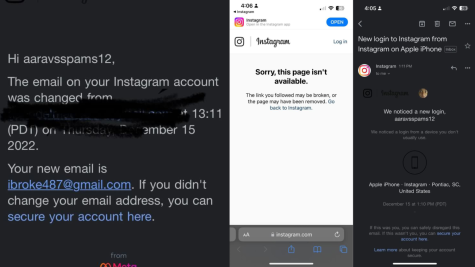Your donation will support the student journalists in the AVJournalism program. Your contribution will allow us to purchase equipment and cover our annual website hosting costs.
Recovery and prevention
In the same Amador Valley Journalism survey, 50.4% of students admitted they were “concerned” or “very concerned” about being hacked on Instagram. In an op-ed from the U.S. News, David Wajsgras argues in favor of early exposure to technology and social media within schools to “prepare a future generation of cyber defenders.”
Cybersecurity club officer Yoshik Andula (‘24) agrees that students need to be more informed about how to recognize and protect themselves from hackers.
“There are multiple security measures that can be taken. Most importantly, never share your password with anyone. Another measure is two factor authentication, a security service Instagram offers which allows us to protect our accounts by requiring any logins to be verified through a text or email,” Andula said.
Aarav Shah (‘26) recently lost his Instagram spam account to a hacker, but saved his main account with two factor authentication. While attempting to get his spam account back, he noticed various issues with the platform’s support service.

He agrees that specific security measures like two-factor authentication can reduce the chance of students losing their accounts. However, he believes the ultimate onus of preventing account hacks lies on Instagram and other social media companies.
“Instagram isn’t doing a very good job. After the email on my spam account was changed, Instagram sent me a confirmation email. However, after clicking the link that said ‘this wasn’t me,’ it led to an error that prevented me from retaining my account. They should also make it easier to report hacked accounts,” Shah said.
Shao had used Instagram’s video selfie identification feature to regain access to his account. The feature asks users to upload a video selfie, in which they turn their head in different directions. Instagram then checks if the video selfie matches photos or posts on the user account to confirm an individual’s identity. Accounts lacking photos showing the user’s face will not be able to use video selfie identification to verify their identities.
According to Instagram Help, the team may take up to two business days to review a submitted video selfie. For Shao, he waited over a week before his video selfie was approved, after which Instagram emailed him a link to reset his password.
Ivonne Lee (‘26), who was targeted by Lim’s hacker, also submitted a video selfie, but said Instagram Support has yet to respond. She reported her original account multiple times, all which were dismissed by Instagram.
“I want my account back. (It has) all my memories of band, which are on my phone, but it’s more fun on Instagram,” Lee said.
Sandeep also reached out to Instagram several times, but couldn’t get his account back. Since then, he has created a new account.
Lim, too, started a new account on Instagram and followed her old profile. To her amusement, the hacker attempted to trick her again, this time asking for a steam card.
A steam card is an online gift card that can only be used to purchase products like video games, software, and in-game items, according to the Steam Powered Help page, which specifically warns users about scammers.
“If someone contacts you to pay them in Steam Wallet Gift Cards, you are most likely targeted in a scam. Never give out a Steam Wallet Gift Card to a person you don’t know,” the website says.
This time, Lim and friends responded to the hacker in kind.